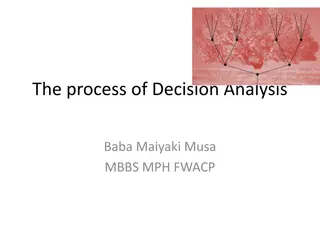
Effective Decision Making and Problem Solving in Information Systems
Developing effective information and decision support systems requires good decision-making and problem-solving skills. This content covers the stages of decision making, importance of implementation and monitoring in problem solving, uses of Management Information Systems (MIS), characteristics of Decision Support Systems (DSS), goals of Group Support Systems (GSS) and Executive Support Systems (ESS), and components of a DSS. It also explores the relationship between decision making and problem solving.
Download Presentation

Please find below an Image/Link to download the presentation.
The content on the website is provided AS IS for your information and personal use only. It may not be sold, licensed, or shared on other websites without obtaining consent from the author. If you encounter any issues during the download, it is possible that the publisher has removed the file from their server.
You are allowed to download the files provided on this website for personal or commercial use, subject to the condition that they are used lawfully. All files are the property of their respective owners.
The content on the website is provided AS IS for your information and personal use only. It may not be sold, licensed, or shared on other websites without obtaining consent from the author.
E N D
Presentation Transcript
Good decision-making and problem-solving skills are the key to developing effective information and decision support systems Define the stages of decision making Discuss the importance of implementation and monitoring in problem solving Principles of Information Systems, Seventh Edition 2
The management information system (MIS) must provide the right information to the right person in the right fashion at the right time Explain the uses of MISs and describe their inputs and outputs Discuss information systems in the functional areas of business organizations Principles of Information Systems, Seventh Edition 3
Decision support systems (DSSs) are used when the problems are unstructured List and discuss important characteristics of DSSs that give them the potential to be effective management support tools Identify and describe the basic components of a DSS Principles of Information Systems, Seventh Edition 4
Specialized support systems, such as group support systems (GSSs) and executive support systems (ESSs), use the overall approach of a DSS in situations such as group and executive decision making State the goals of a GSS and identify the characteristics that distinguish it from a DSS Identify the fundamental uses of an ESS and list the characteristics of such a system Principles of Information Systems, Seventh Edition 5
Decision Making and Problem Solving: Decision Making as a Component of Problem Solving Decision-making phase: first part of problem-solving process Intelligence stage: potential problems or opportunities are identified and defined Design stage: alternative solutions to the problem are developed Choice stage: requires selecting a course of action Principles of Information Systems, Seventh Edition 6
Figure 10.1: How Decision Making Relates to Problem Solving Principles of Information Systems, Seventh Edition 7
Decision Making as a Component of Problem Solving (continued) Problem solving: a process that goes beyond decision making to include the implementation stage Implementation stage: a solution is put into effect Monitoring stage: decision makers evaluate the implementation Principles of Information Systems, Seventh Edition 8
Programmed Versus Nonprogrammed Decisions Programmed decisions Decision made using a rule, procedure, or quantitative method Easy to computerize using traditional information systems Principles of Information Systems, Seventh Edition 9
Programmed Versus Nonprogrammed Decisions (continued) Nonprogrammed decisions Decision that deals with unusual or exceptional situations Not easily quantifiable Principles of Information Systems, Seventh Edition 10
Optimization, Satisficing, and Heuristic Approaches Optimization model: a process to find the best solution, usually the one that will best help the organization meet its goals Satisficing model: find a good but not necessarily the best problem solution Heuristics: commonly accepted guidelines or procedures that usually find a good solution Principles of Information Systems, Seventh Edition 11
An Overview of Management Information Systems: Management Information Systems in Perspective A management information system (MIS) provides managers with information that supports effective decision making and provides feedback on daily operations The use of MISs spans all levels of management Principles of Information Systems, Seventh Edition 12
Figure 10.3: Sources of Managerial Information Principles of Information Systems, Seventh Edition 13
Inputs to a Management Information System Internal data sources (TPSs and ERP systems and related databases; data warehouses and data marts; specific functional areas throughout the firm) External data sources (Customers, suppliers, competitors, and stockholders whose data is not already captured by the TPS; the Internet; extranets) Principles of Information Systems, Seventh Edition 14
Outputs of a Management Information System Scheduled report: produced periodically, or on a schedule Key-indicator report:summary of the previous day s critical activities Demand report: developed to give certain information at someone s request Exception report: automatically produced when a situation is unusual or requires management action Drill-down reports: provide increasingly detailed data about a situation Principles of Information Systems, Seventh Edition 15
Characteristics of a Management Information System Fixed format, standard reports Hard-copy and soft-copy reports Uses internal data User-developed reports Users must request formal reports from IS department Principles of Information Systems, Seventh Edition 16
Functional Aspects of the MIS Most organizations are structured along functional lines or areas MIS can be divided along functional lines to produce reports tailored to individual functions Principles of Information Systems, Seventh Edition 17
Figure 10.5: MIS is an integrated collection of functional information systems Principles of Information Systems, Seventh Edition 18
Financial Management Information Systems Financial MIS: provides financial information to all financial managers within an organization Profit/loss and cost systems Auditing Uses and management of funds Principles of Information Systems, Seventh Edition 19
Figure 10.6: Overview of a Financial MIS Principles of Information Systems, Seventh Edition 20
Manufacturing Management Information Systems The manufacturing MIS subsystems and outputs monitor and control the flow of materials, products, and services through the organization Design and engineering Master production scheduling and inventory control Process control Quality control and testing Principles of Information Systems, Seventh Edition 21
Figure 10.7: Overview of a Manufacturing MIS Principles of Information Systems, Seventh Edition 22
Marketing Management Information Systems Marketing MIS: supports managerial activities in product development, distribution, pricing decisions, and promotional effectiveness Marketing research Product development Promotion and advertising Product pricing Principles of Information Systems, Seventh Edition 23
Figure 10.10: Overview of a Marketing MIS Principles of Information Systems, Seventh Edition 24
Human Resource Management Information Systems Human resource MIS: concerned with activities related to employees and potential employees of an organization Human resource planning Personnel selection and recruiting Principles of Information Systems, Seventh Edition 25
Human Resource Management Information Systems (continued) Training and skills inventory Scheduling and job placement Wage and salary administration Outplacement Principles of Information Systems, Seventh Edition 26
Figure 10.13: Overview of a Human Resource MIS Principles of Information Systems, Seventh Edition 27
Other Management Information Systems Accounting MIS: provides aggregate information on accounts payable, accounts receivable, payroll, and many other applications Geographic information system (GIS): capable of assembling, storing, manipulating, and displaying geographic information Principles of Information Systems, Seventh Edition 28
An Overview Of Decision Support Systems A DSS is an organized collection of people, procedures, software, databases, and devices used to support problem- specific decision making and problem solving The focus of a DSS is on decision-making effectiveness when faced with unstructured or semistructured business problems Principles of Information Systems, Seventh Edition 29
Characteristics of Decision Support Systems Handle large amounts of data from different sources Provide report and presentation flexibility Offer both textual and graphical orientation Support drill-down analysis Principles of Information Systems, Seventh Edition 30
Characteristics of Decision Support Systems (continued) Perform complex, sophisticated analysis and comparisons using advanced software packages Support optimization, satisficing, and heuristic approaches Simulation What-if analysis Goal-seeking analysis Principles of Information Systems, Seventh Edition 31
Capabilities of a Decision Support System Support all problem-solving phases Support different decision frequencies Support different problem structures Support various decision-making levels Principles of Information Systems, Seventh Edition 32
Figure 10.15: Decision-Making Level Principles of Information Systems, Seventh Edition 33
Table 10.3: Comparison of DSSs and MISs Principles of Information Systems, Seventh Edition 34
Table 10.3: Comparison of DSSs and MISs (continued) Principles of Information Systems, Seventh Edition 35
Components of a Decision Support System Model base: provides decision makers access to a variety of models and assists them in decision making Database External database access Access to the Internet and corporate intranet, networks, and other computer systems Dialogue manager: allows decision makers to easily access and manipulate the DSS and to use common business terms and phrases Principles of Information Systems, Seventh Edition 36
Figure 10.16: Conceptual Model of a DSS Principles of Information Systems, Seventh Edition 37
Group Support Systems Group support system (GSS) Consists of most elements in a DSS, plus software to provide effective support in group decision making Also called group support system or computerized collaborative work system Principles of Information Systems, Seventh Edition 38
Figure 10.17: Configuration of a GSS Principles of Information Systems, Seventh Edition 39
Characteristics of a GSS That Enhance Decision Making Special design Ease of use Flexibility Decision-making support Principles of Information Systems, Seventh Edition 40
Characteristics of a GSS That Enhance Decision Making (continued) Anonymous input Reduction of negative group behavior Parallel communication Automated record keeping Principles of Information Systems, Seventh Edition 41
Figure 10.18: GSS Alternatives Principles of Information Systems, Seventh Edition 42
Executive Support Systems Executive support system (ESS): specialized DSS that includes all hardware, software, data, procedures, and people used to assist senior-level executives within the organization Principles of Information Systems, Seventh Edition 43
Executive Support Systems in Perspective Tailored to individual executives Easy to use Drill-down capabilities Support need for external data Principles of Information Systems, Seventh Edition 44
Executive Support Systems in Perspective (continued) Can help when uncertainty is high Future-oriented Linked to value-added processes Principles of Information Systems, Seventh Edition 45
Capabilities of Executive Support Systems Support for defining an overall vision Support for strategic planning Support for strategic organizing and staffing Support for strategic control Support for crisis management Principles of Information Systems, Seventh Edition 46
Summary The decision-making phase of the problem-solving process includes three stages: intelligence, design, and choice A management information system (MIS) provides managers with information that supports effective decision making and provides feedback on daily operations A financial MIS provides financial information to all financial managers within an organization Principles of Information Systems, Seventh Edition 47
Summary (continued) The manufacturing MIS subsystems and outputs monitor and control the flow of materials, products, and services through the organization A marketing MIS supports managerial activities in product development, distribution, pricing decisions, and promotional effectiveness A human resource MIS is concerned with activities related to employees and potential employees of an organization Principles of Information Systems, Seventh Edition 48
Summary (continued) A DSS is an organized collection of people, procedures, software, databases, and devices used to support decision making and problem solving A group support system (GSS) consists of most elements in a DSS, plus software to provide effective support in group decision making An executive support system (ESS) is a specialized DSS that includes all hardware, software, data, procedures, and people used to assist senior-level executives within the organization Principles of Information Systems, Seventh Edition 49





















